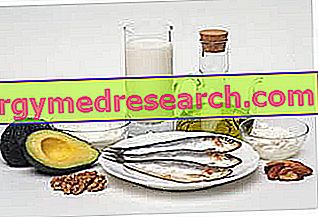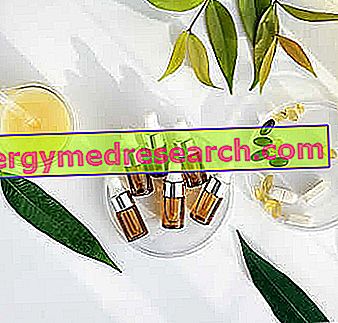See also: good cholesterol and bad cholesterol
Introduction

Fats and / or lipids: functions
Lipids, commonly (and from the chemical point of view improperly) also called fats, are macromolecules useful to the human organism; they represent a more heterogeneous group than proteins and glucides, therefore, their classification and the relative functional analysis are at least complex.
Outline of fat classification
According to the Lehlinger classification, fats can be classified into simple and complex based on the assumption that they constitute one or more molecules:
- Simple or NON saponifying: aliphatic alcohols, sterols (mainly cholesterol and phytosterols), tocopherols (vit E), terpenic alcohols, triterpene dialkols, hydrocarbons (toxic).
- Complexes or saponifiable: tri-, di-, mono-acylglycerols; phospholipids, fatty acids, sterol esters; the waxes are composed of 2 fatty acids + ethylene glycol ... not like the fats that are composed of glycerin + 3 fatty acids.
Functions of fats: sometimes good and sometimes bad
Trying to make the article less scientific and more "palatable", below we will analyze all types of food fats / lipids individually (but without going into details); in particular, we will try to describe the functional impact on the organism, distinguishing good fats from bad fats .
Simple fats: are they good or bad?
Aliphatic alcohols, terpene alcohols and triterpene dialkols
They are organic compounds (similar to fatty acids) naturally present in foods that, by determining the basic structure of essential oils, give the typical "aroma" to foods (eg: menthol, citronellol ...). MINOR lipid compounds are to be considered as average GOOD FATS.
NB . The most popular alcohols in nutrition are METHANOL and ETHANOL, two naturally POCO molecules present (or present only in trace) in food. The first is a TOXIC fuel for the body (therefore a BAD molecule), while the second is a less toxic (even if dose-dependent) product present in fermented and distilled beverages.
Steroli :
They are chemical compounds derived from sterol (chemically defined as a polycyclic compound consisting of four rings). They differ in zoosterols (present in animal organisms: cholesterol, steroid hormones and vitamin D) and phytosterols (present in plant organisms: the best known are campesterol, sitosterol and stigmasterol).
- Food zoosterols are naturally present in foods of animal origin; the most important are cholesterol (considered a BAD FAT because its excess in the blood is responsible for the increase in mortality from cardiovascular diseases) and the various forms of vit. D or calciferol (considered a GOOD FAT as it acts as an ESSENTIAL vitamin or provitamin for bone calcification and osteoporosis prevention).
- Food phytosterols (and similarly stanols and polycosanols), are contained above all in some seasoning oils, legumes, vegetables and fruit; they represent a range of molecules with different functions, including: antioxidant, antitumor, cholesterol-lowering, estrogen-like; it would be indispensable to dedicate an entire chapter to their functions but, what is certain, is that they are considered absolutely GOOD FATS.
Tocopherols :
Also known by the name of vit. E. They are a group of ESSENTIAL molecules (contained in vegetable oils and vegetables) as they perform the anti-oxidant and anti-thrombotic blood thinning functions. They are absolutely to be included among the GOOD FATS.
Hydrocarbons :
They are organic compounds without the functional group. They include two categories of molecules (aliphatic and aromatic), different both from the chemical and physical-structural point of view; in this regard, it is however essential to remember that: "in violent cooking and at very high temperatures, the carbonization of some macronutrients gives rise to the formation of polynuclear aromatic hydrocarbons, also called polycyclic aromatics (such as ANTRACENE), and to acrolein These, in addition to being pollutants, possess a highly toxic, irritating and CARCINOGENO effect. "
Polycyclic aromatic hydrocarbons and acrolein are volatile lipid derivatives considered to be ABSOLUTELY BAD FATS (to be avoided or consumed in the minimum amount possible).
Complex fats: are they good or bad?
Fatty acids and tri-, di-, mono-acylglycerols (glycerol esters or triglycerides):
They are useful lipids for energy intake; fatty acids provide 9kcal / g and should represent between 25 and 30% of calories in the diet. There is an essential difference in the quality of fatty acids, which in the first analysis can be differentiated into SATURI and INSATURI;
- the SATURI (mainly deriving from animal-type foods) are commonly called BAD FATS because, while providing the same calories as others, they tend to raise circulating LDL cholesterol favoring the onset of cardiovascular diseases.
- The INSATURES (mainly deriving from plant-type foods), on the contrary, are very useful in the preservation and cooking of foods (monounsaturated, contained above all in extra virgin olive oil), and also include a category of molecules of which some are essential ( polyunsaturated, mainly contained in seasoning oils, dried fruit, blue fish and fish oil). These essential fatty acids (AGE or PUFA) belong to the family of omega3 (contained above all in blue fish, fish oil, krill oil and some vegetable oils) and omega6 (contained above all in vegetable oils and in dried fruit), and possess very important functions for the organism.
- Ultimately, monounsaturated fatty acids can be considered GOOD FAT as long as they are made in a suitable measure, beyond which, such as SATURI and NON essential polyunsaturated fats, contribute to the increase in body weight by adipose deposit; while ESSENTIAL polyunsaturated fatty acids, if introduced in the right reciprocal relationship (omega3: omega6 = 1: 3 or more in favor of omega3), are considered absolutely GOOD FATS.
NB . There is a category of MANIPULATED INDUSTRIAL lipids called HYDROGENATED FATS; these, although originally unsaturated, are industrially subjected to hydrogenation to acquire the physical properties of the SATURI. From the metabolic point of view they behave exactly like the saturated fatty acids MA sometimes contain a significant amount of TRANS fatty acids, UNDESIDER molecules (naturally present only in traces in foods). The hydrogenated fats, and above all the trans molecules, at or below the saturated fats are considered ABSOLUTELY BAD FATS (to be avoided or consumed in the minimum possible quantity).
Phospholipids :
They are esters of glycerol associated with fatty acids and a phosphate group; they are contained above all in the offal (brain) and represent fundamental molecules especially for the constitution "of the polar liquid mosaic", typical of cellular membranes, and the structuring of the myelin sheaths of the nervous system. The organism is also able to produce them autonomously, therefore, from the food point of view they are considered GOOD FATS but not ESSENTIAL.
Sterol esters : See above: Sterols .
Wax:
They are not important lipids from the nutritional point of view but sometimes they are used as additives (carnauba wax and beeswax). In feeding, the most famous wax is the bloom, a natural film to protect the berries; on the contrary, beeswax is separated from honey and therefore is not a significant food component. The waxes do not represent a BAD GREASE but not even a GOOD or ESSENTIAL GREASE.



